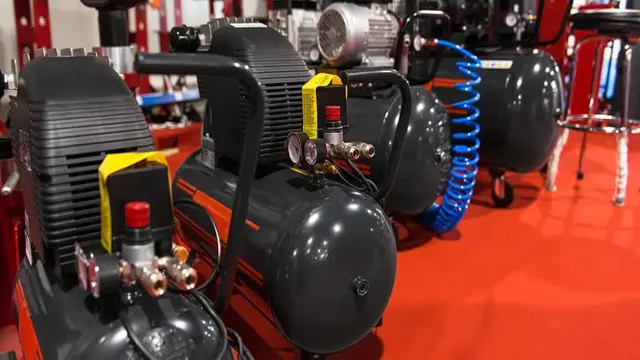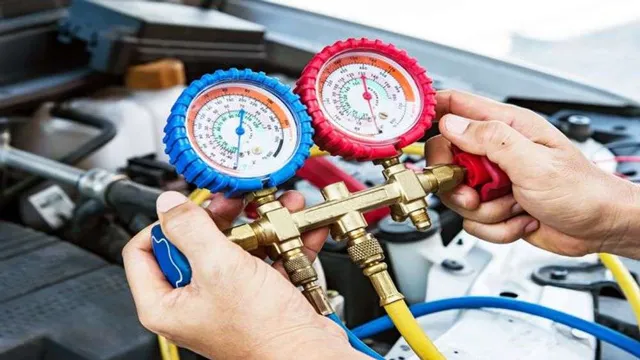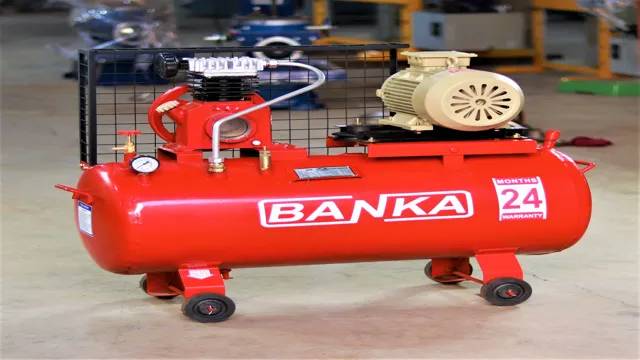How Many CFM Air Compressor Do I Need for My Air Tools: A Comprehensive Guide

When it comes to selecting an air compressor for your project, it’s essential to consider the amount of air volume you require to get the job done. But with so many options out there and technical terms to decipher, figuring out how many CFM air compressor you need can be a daunting task. Don’t worry; we’ve got you covered! In this blog, we’ll take you step-by-step through everything you need to know to get the right CFM rating for your air compressor.
From understanding what CFM is to determining your air tool’s CFM requirement, we’ll break it down for you in simple terms that you can easily understand. So, let’s get started and help you find the perfect air compressor for your job!
Understanding CFM
When it comes to choosing an air compressor, understanding CFM or cubic feet per minute is important in determining how much air pressure it can deliver. The question of how many CFM air compressor do I need largely depends on the type of work you’ll be doing. If you’re just using it for small DIY projects at home, a compressor with a lower CFM rating would suffice.
However, for heavy-duty tasks such as sandblasting or spray painting, you’ll need a compressor with a higher CFM rating. It’s important to note that CFM is just one factor to consider when choosing a compressor; tank size and horsepower also play crucial roles in determining its efficacy and efficiency. Ultimately, understanding your specific needs and the demands of your projects will help you choose the right air compressor for your needs.
What is CFM?
CFM stands for cubic feet per minute, a unit of measurement used to indicate the volume of air that flows in and out of a space in a minute. This unit is commonly used in the heating, ventilation, and air conditioning (HVAC) industry and is an important metric when choosing the right equipment for a specific space. Understanding CFM is crucial as it helps determine the amount of air required to effectively cool or heat a room and maintain proper ventilation.
The higher the CFM, the more air moves through the system, resulting in better air quality and circulation. When selecting HVAC equipment or looking for ways to improve indoor air quality, consider the CFM rating and ensure your system meets the requirements for your space.

How does CFM relate to air compressors?
CFM, air compressors CFM stands for cubic feet per minute, which is a measurement of the airflow produced by an air compressor. It’s a crucial factor to consider when purchasing an air compressor as it determines the machine’s ability to power pneumatic tools. The CFM rating indicates the maximum airflow output the compressor can deliver in a minute at a specific PSI.
Insufficient CFM means that the compressor will not have enough power to operate high-demand tools, leading to performance issues. Therefore, it’s essential to choose an air compressor with a CFM rating that can handle the tools you’re using. With a higher CFM rating, the compressor can power heavier equipment such as sanders, grinders, and buffers.
In contrast, a lower CFM rating is suitable for simple tools such as nail guns and staple guns. In conclusion, understanding CFM is essential in deciding which air compressor is appropriate for the intended task.
Factors to Consider
When choosing an air compressor, one of the most important factors to consider is how many CFM (cubic feet per minute) you need. CFM measures the volume of air that the compressor can produce at a given pressure. The CFM requirement will depend on the type of tool or equipment you’ll be using and its specific CFM requirements.
A general rule of thumb is that the CFM rating of your air compressor should be at least 5 times the required CFM of your tool. For example, if your tool requires 8 CFM, then you should choose an air compressor with a CFM of 12 or higher.
It’s also important to factor in any additional tools or equipment that you may need in the future, to ensure that your compressor can handle any future needs. Keep in mind that a higher CFM rating typically means a higher price, so it’s important to find the right balance between your budget and your needs.
What is the intended use of the air compressor?
When considering purchasing an air compressor, it’s important to think about the intended use. There are a variety of factors that should be taken into consideration before making a decision. Firstly, you need to think about the type of work you will be doing.
Are you planning on using the air compressor for personal or professional use? The amount of usage will affect the type of compressor you need. Secondly, consider the type of tools you will be using. Different air compressors come with different pressure ranges, so it’s important to match the compressor to the tools you’ll be using.
Finally, consider the size and weight of the compressor. If you’re using it for professional use, you might want to consider a larger, more heavy-duty compressor that can handle heavier workloads with ease. In short, the intended use is an important factor to consider when purchasing an air compressor as it will affect the type, size, and usage of the compressor you need.
How many tools will be used simultaneously?
When it comes to determining how many tools you can use simultaneously, there are a few factors to consider. Firstly, think about the nature of the tasks you will be performing. Certain tasks may require multiple tools, while others can be completed with one or two.
Secondly, consider the resources you have available, such as hardware and software. Different tools may require different levels of processing power and memory, so ensure that your computer can accommodate the number of tools you plan to use. Additionally, think about your own personal capabilities and preferences.
Some people may be able to multitask more effectively than others, while others may find it overwhelming to juggle too many tools at once. Ultimately, the number of tools you can use simultaneously will depend on a variety of factors, and it’s important to find the right balance that works for you. Whether it’s using three tools simultaneously or just one, the goal is to be efficient and effective in your work.
So, find what works best for you and don’t forget to utilize the correct keywords for your search engine optimization strategy.
What is the PSI requirement of the tools?
When it comes to pneumatic tools, the required PSI will depend on the specific tool and its intended use. Factors to consider when determining the PSI requirement include the size of the tool, the air consumption rate, and the type of project you will be using it for. For example, a larger tool that requires more power, such as a sandblaster, will generally require a higher PSI than a smaller tool like an air drill.
Additionally, a tool that requires continuous use, like an air sander, will also require a higher PSI to maintain consistent performance. It’s always important to refer to the manufacturer’s instructions for the recommended PSI range, as using a lower or higher pressure can result in damage to the tool or poor performance. With these factors in mind, you can select a compatible air compressor and ensure that your pneumatic tools are working at their best.
Calculating CFM Requirement
Are you wondering how many CFM air compressor do you need? It’s important to figure out the right CFM requirement to ensure that your compressor can keep up with your work demands. One way to calculate the required CFM is to add up the CFM requirement of all the air tools you plan to use simultaneously. For example, if you plan to use a spray gun that requires 6 CFM and a sander that requires 8 CFM, you will need a compressor with a minimum CFM rating of 1
Consider the duty cycle of your air compressor as well, as continuous use of a compressor with a lower CFM rating than required can lead to overheating and damage. Furthermore, it’s essential to consider the maximum pressure requirement of your air tools. So, always make sure to do your homework before making a purchase and choose an air compressor that meets your requirements without sacrificing quality.
Step-by-step guide to calculating CFM requirement
When it comes to calculating the CFM (cubic feet per minute) requirement for a ventilation system, there are a few steps to follow. The first step is to determine the square footage of the space that needs to be ventilated. This can be done by measuring the length and width of the room and multiplying the two numbers together.
Once you have the square footage, the next step is to determine the air changes per hour (ACH) required for the space. ACH refers to the number of times the air in the room needs to be exchanged with fresh air in an hour. This number depends on the type of space you are ventilating and its intended use.
For example, a bathroom typically requires an ACH of 8-10, while a large office may only require an ACH of 2- Finally, once you have determined the required ACH for the space, you can use a CFM calculator to determine the total CFM requirement for your ventilation system. By following these steps, you will have a good idea of the CFM requirement for your space and can ensure that your ventilation system is designed to meet the specific needs of your environment.
Typical CFM requirements for common tools
Calculating CFM Requirement When it comes to selecting the right air compressor for your workshop, it’s crucial to ensure it meets the CFM (cubic feet per minute) requirements of your tools. CFM indicates how much air a tool or machine requires to function correctly. The typical CFM requirements for common tools are essential to understand.
For instance, drills require about 4-6 CFM, while sanders need 6-10 CFM. Similarly, paint sprayers may need 7-13 CFM, while grinders may need 5-8 CFM. Calculating the CFM requirement for each tool in your shop will help you determine the minimum CFM required from your air compressor.
It’s always a good idea to choose an air compressor that can provide slightly more CFM to avoid power shortages or delays in your projects. With the right CFM requirement in mind, you’ll be sure to select the perfect air compressor to meet all your needs.
Choosing the Proper Air Compressor
If you’re wondering how many CFM air compressor you need, it depends on your specific application. CFM, or cubic feet per minute, measures the amount of air that the compressor can deliver at a given time. To determine your required CFM, you need to consider the tools or equipment you will be using with the compressor.
Each tool has its own CFM requirement, and you will want to choose a compressor that can handle the tool with the highest CFM requirement. Additionally, you should consider the duty cycle of the compressor, which refers to the amount of time it can operate before requiring a cool-down period. Overall, make sure to do your research and choose a compressor that can handle your current needs and any potential future needs to avoid any disappointments later on.
Selecting the air compressor with the necessary CFM
When selecting an air compressor, it’s crucial to choose one with the necessary CFM (cubic feet per minute) for your specific needs. CFM refers to the amount of air that an air compressor can deliver at a given time, and it’s an essential factor in determining the efficiency of your equipment. Choosing a compressor with too little CFM will result in poor performance, while selecting one with too much will result in wasted energy and higher costs.
To determine the correct CFM for your applications, consider the tools you’ll use the most frequently and their individual requirements. It’s best to choose a compressor with a slightly higher CFM than your most demanding tool to ensure proper performance. Keep in mind that CFM is also affected by temperature, humidity, and altitude, so it’s essential to take those variables into account when making your decision.
Overall, selecting the proper CFM for your air compressor is critical to the success of your projects, and taking the time to carefully evaluate your needs and choose an appropriate compressor will pay off in the long run.
Other factors to consider when choosing an air compressor
Choosing the proper air compressor is essential for ensuring efficient and effective performance. Apart from the type of air compressor, there are various other factors you should consider when choosing one. For instance, you need to consider the power source, such as electric-powered or gas-powered, based on the tasks at hand and the availability of power at the job site.
Another important factor to consider is the tank size. If you’re using multiple power tools, you’ll require a bigger tank capacity than if you’re only using one tool. Additionally, you should consider the airflow requirements, which will affect the volume of air delivered and the pressure level.
Lastly, you should consider the portability of the compressor, whether you require a stationary or a mobile compressor. By bearing all these factors in mind, you can choose an air compressor that aligns with your work requirements and delivers optimal results.
Examples of air compressors with various CFM outputs
Choosing the proper air compressor is crucial to ensure efficient and effective end results. One key factor to consider is the CFM output, which stands for cubic feet per minute. Different air compressors have varying CFM outputs, with higher outputs indicating higher air volume delivery.
For instance, a 2 CFM air compressor may be suitable for light-duty tasks, such as inflating tires and powering small tools, while a 10 CFM air compressor would be suitable for heavy-duty applications like sandblasting, painting, and operating large air tools. Examples of air compressors with various CFM outputs include the 2 CFM California Air Tools 5510SE, 5 CFM DeWalt DXCMV5076055, and 10 CFM Ingersoll Rand 2475F14G. Choosing the right CFM output for your specific task will help prevent disruptions or safety hazards, enhancing your productivity and satisfaction.
Conclusion
In the end, choosing the right CFM air compressor is a lot like finding the perfect partner – it all depends on your needs and desires. Do you want something small and efficient to power a few tools? Or do you need a heavy-duty workhorse to tackle bigger jobs? Either way, taking the time to understand your specific needs and researching the options available is the key to finding the perfect match. So, whether you’re a DIY enthusiast or a seasoned professional, choosing the right CFM air compressor will ensure that your tools stay powered up and your workload stays manageable.
“
FAQs
1. What is CFM in an air compressor and why is it important? A: CFM stands for cubic feet per minute, which is a measurement of the air flow rate. It’s important because it determines the amount of air that can be delivered by the compressor at a specific pressure level. 2. How do I calculate the CFM requirements for my air tools? A: Most air tools will have a specified CFM requirement listed in their manual, and you can add up the CFM requirements for all of your tools to determine the total CFM needed for your compressor. 3. What factors should I consider when choosing the right CFM air compressor for my needs? A: You should consider factors such as the size of your air tools, the frequency of use, the pressure requirements, and the available power supply to determine the appropriate CFM rating for your compressor. 4. Can I use a lower CFM compressor with my air tools? A: It’s possible, but you may experience reduced performance or even damage to the tools if the compressor is unable to deliver sufficient air flow. 5. Is it better to have a higher CFM air compressor than what I need for my tools? A: It can be beneficial to have a higher CFM rating, as it allows for more flexibility and can prevent strain on the compressor during heavy use. 6. Are there ways to increase the CFM output of my existing air compressor? A: Some options include adding a larger tank, upgrading the compressor’s motor or pump, or decreasing the length of air hose between the compressor and tools. 7. Can I use multiple smaller compressors instead of one larger unit to achieve the necessary CFM output? A: It’s possible, but it can be less efficient and more expensive than using a single compressor with the appropriate CFM rating.



